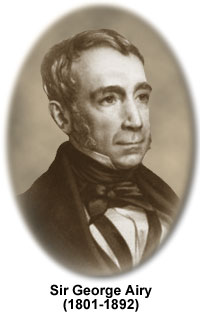Sir George Biddell Airy
(1801-1892)

Sir George Airy was a distinguished nineteenth century English Astronomer Royal who carried out optical research and first drew attention to the visual defect of astigmatism. After graduating from Trinity College, Cambridge in 1823, Airy worked as a mathematics tutor, but was later better-known for his skills in Latin and ancient Greek, poetry, history, theology, architecture, engineering, geology, and his then-controversial beliefs in separating education from religion. By 1826, Airy's interest in astronomy increased dramatically when he was a Professor of Mathematics at Cambridge University. He published a treatise entitled Mathematical Tracts on Physical Astronomy and by 1828, became Professor of Astronomy and Director of the Cambridge Observatory.
Under Airy, the Observatory blossomed from simply providing data to the Royal Navy to a major research institution with the addition of the Altazimuth telescope in 1847 and the Airy Transit Circle. Departments in magnetism and meteorology were subsequently added and regular observations of sunspots and spectroscopy were conducted on a routine basis. From studying eclipses to measuring gravity, Airy's extra-observatory activities were varied, and included his supervision of the first transatlantic telegraph cable placement and the construction of Big Ben's chimes. It took four offers by the Queen, before he agreed to become Sir George in July 1872. Known for his sarcasm and caustic personality, Airy had an ongoing battle with Charles Babbage in which he prevailed professionally and financially to the detriment of science. Airy's infamy ranges from ignoring John Adams' discovery of Neptune to dismissing Michael Faraday's field theory.
In the field of optics, Airy's water telescope helped erase the antiquated theory of Šther, the substance in air through which light was supposed to travel, laying the groundwork for Einstein's Theory of Relativity. Suffering from astigmatism, he manufactured the first correcting eyeglasses (1825), with a cylindrical lens design that is still in use. The diffraction disks that bear his name (Airy Disks) were discovered in the spherical center of a wavefront traveling through a circular aperture. These diffraction patterns form the smallest unit that comprises an image, thus determining the limits of optical resolution.
